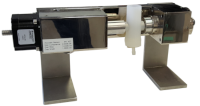The electric conductivity of a liquid remains an important parameter for the determination of ionic composition and purity in oils and other unpolar solvents. In dispersions, this parameter is an indicator for colloidal properties of particles dispersed within a given media. We are offering probes for both aqueous as well as organic-based media with very low conductivity.
An essential parameter for the characterization of droplets in emulsions or particles in suspensions is the particle size distribution. We offer a variety of different instruments and methods to tackle the different challenges in application, no matter if in quality control or in research and development.
Bettersizer S3 Plus:
Particle size and particle shape
0.01 – 3500 µm
Bettersizer S3:
Particle size 0.01 – 3500 µm
Bettersizer 2600:
Particle size 0.02 – 2600 µm
Bettersizer ST:
Particle size measurement 0.1 – 1,000 µm
A detailed description of static light scattering and laser diffraction can be found here.
Dynamic light scattering (DLS) is applied in measuring particle sizes on a nano- and submicrometer scale.
Particle size analyses 0.3 nm to 15 µm
A detailed description of dynamic light scattering can be found here.
Characterization of the particle size distribution in concentrated suspensions or emulsions commonly found in ceramics and construction industry as well as food and cosmetic applications, requires a method to analyze samples in their original concentrations and on a macroscopic scale. This can be achieved by employing acoustic spectrometry, which determines particle sizes in proportion to their respective masses by measuring the damping of ultrasonic waves in concentrated dispersion with particle sizes on the nanometer to micrometer scale.
 DT-100/DT-110:
DT-100/DT-110:
Particle size 5 nm – 1000 µm; measuring in original concentration up to 50 Vol.-%
DT-1202:
Particle size 5 nm – 1000 µm; measuring in original concentration up to 50 Vol.-%; measuring zeta potential
A detailed description of acoustic spectrometry can be found here.
In a number of applications it is not only required to determine particle size distributions for further processing of a powder, but to analyze particle shape as well. Color, procession and dispersion characteristics as well as mechanic properties are influenced by particle shape significantly. Furthermore, anisotropic shapes such as rods may exhibit problems when using standard particle size analysis without imaging processes.
Particle size and particle shape 2 – 10000 µm
Particle size and particle shape 0.01 – 3500 µm
A detailed description of imaging analysis can be found here.
The stability of emulsions or suspensions with regards towards particle migration of agglomeration is a key paramter for storing or processing of such materials. For this we offer an application with multi light scattering (MLS), which can determine these characteristics in real-time and on the original system.

Contract analysis dispersion stability
The zeta potential is an indicator for the stability of a dispersion and the mobility of its particles in external fields. A characteristic value is the isoelectrical point (IEP, zeta potential = 0), at which the particles agglomerate and the system precipitates. With electroacoustics we offer a method, by which these parameters can be determined in original concentration.
A detailed description of electroacoustics can be found here.